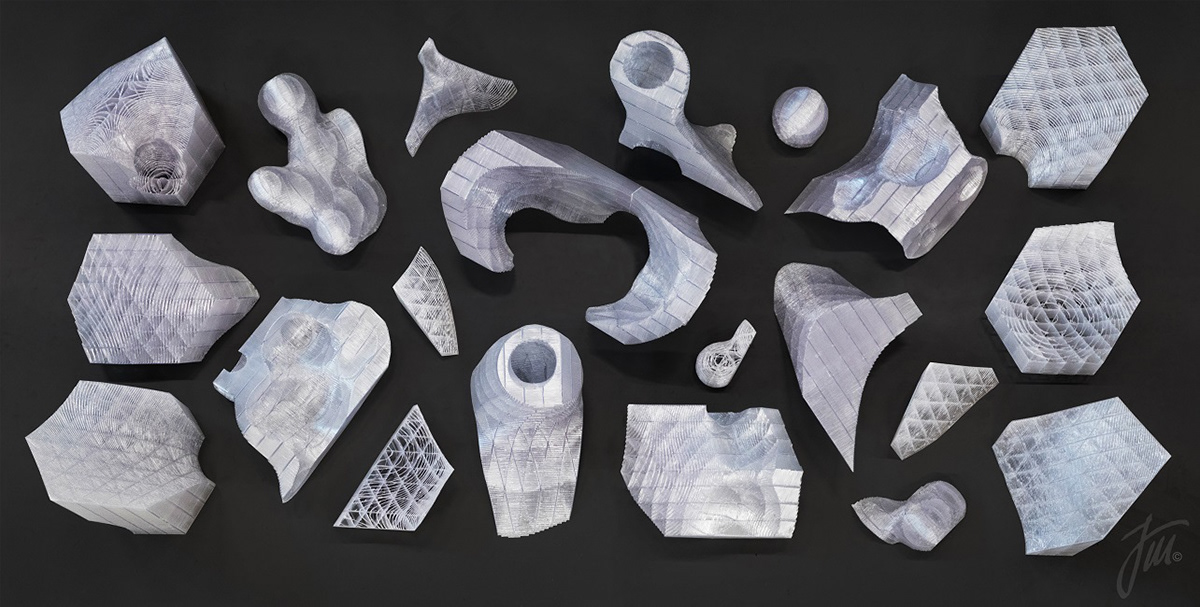▲
H.O.R.T.U.S. XL Astaxanthin.g
▼

H.O.R.T.U.S. XL is an experimental installation developed jointly with EcoLogicStudio and Innsbruck University. The design is featured in the exhibition “Le Fabrique du Vivant” at the Centre Pompidou in Paris from 20 February to 15 April 2019. The work showcases advancements in computational intelligence, in the study of biological models of endosymbiosis, and in additive manufacturing through large scale 3D printing technology.
In H.O.R.T.U.S. XL a digital algorithm is used to develop the growth of an organic shape, that is deposited in layers of 400 microns, forming tailored construction blocks inscribed in a hexagonal grid with a height of 320 mm. Photosynthetic cyanobacteria are inoculated on a biogel medium into the individual triangular cells; their metabolisms, powered by photosynthesis, converts radiation into actual oxygen and biomass. The density-value of each bio-pixel is digitally computed in order to optimally arrange the photosynthetic organisms along iso-surfaces of increased incoming radiation.
My main tasks included the development of a suitable 3D printing system, the production of 70% of the total volume and the general photography.
PRODUCTION
The experimental structure is made of 185 different components, all of them 3D printed in the space of three months.The PETG thermoplastic material used for 3D printing ensures high chemical resistance and full recyclability.
Every 3D piece has undergone a quality check and then weighted, marked and photographed for the archive. Additional pictures of groups and details were taken in order to study the light effects of the material and the spatial attributes of the structure.







ASSEMBLY
The three clusters were put together at the Centre Pompidou. All the pieces are kept together by a series of laser-cut pins in order to allow easier assembling and disassembling.
The positions of white and uv lights were studied in order to maximise the cyanobacteria performance and highlight the details of the pieces.







DETAILS
Every 3D piece has undergone a quality check and then weighted, marked and photographed for the archive. Additional pictures of groups and details were taken in order to study the light effects of the material and the spatial attributes of the structure.










INOCULATION
These 3D printed units have an internal infill structure based on triangles of 46 mm edge where Photosynthetic Cyanobacteria are inoculated on a biogel suspension. The structure is enclosed externally by a porous shell which favours light and air exchange with the biological compound.
The metabolic machines of the Cyanobacteria convert radiation into actual processes of photosynthesis, oxygenation and biomass production, digitally mediated to arrange the photosynthetic organisms along iso-surfaces of increased incoming radiation.







INAUGURATION
In the exhibition, the visitors can move freely around and inside the installation, observing the bio-digital landscape characterized by protuberant 3D printed geometries and engaging in an exchange with the micro-algae. The micro-organisms does indeed absorb the carbon dioxide, including the one produced by human breathing, and transform it into oxygen in a process that also creates biomass, useful for the production of bioplastic material and energy.


▲
H.O.R.T.U.S. _reimagined
photo series coming soon...
▼

Project Credits
HORTUS_XL | Astaxanthin.g, 2019
3D printed substratum, micro-algae in bio-gel medium
3D printed substratum, micro-algae in bio-gel medium
Design: ecoLogicStudio (Claudia Pasquero, Marco Poletto and Kostantinos Alexoupolous)
Synthetic Landscape Lab, Innsbruck University (Prof. Claudia Pasquero and Maria Kuptsova, Terezia Greskova)
System and Production Development: CREATE Group - University of Southern Denmark (SDU), WASP Hub Denmark (Prof. Roberto Naboni and Furio Magaraggia)
Structural Engineering: Nous Engineering, Manja Van De Vorp
Photography: Furio Magaraggia






